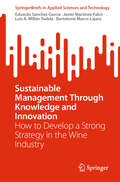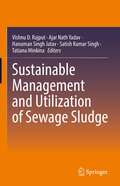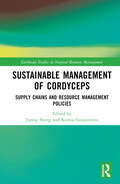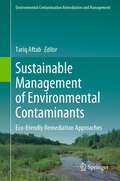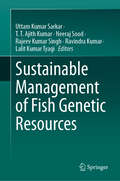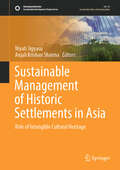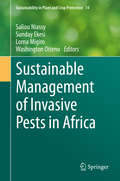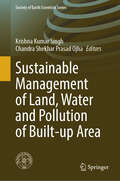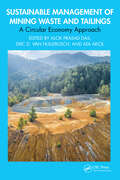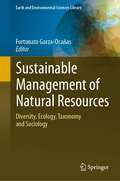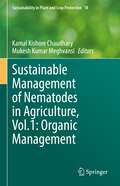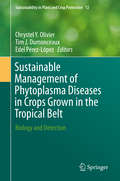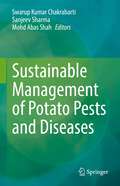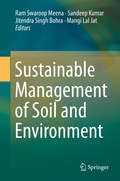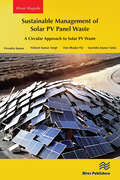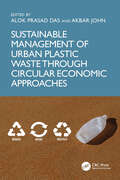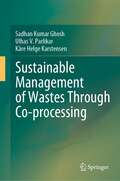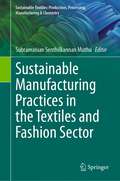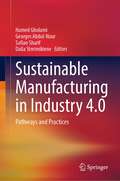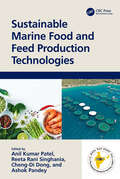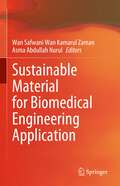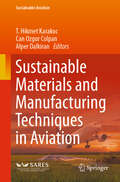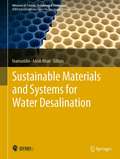- Table View
- List View
Sustainable Management Through Knowledge and Innovation: How to Develop a Strong Strategy in the Wine Industry (SpringerBriefs in Applied Sciences and Technology)
by Javier Martínez-Falcó Bartolomé Marco-Lajara Eduardo Sánchez-García Luis A. Millán-TudelaThis book explores multiple types of innovation within the modern wine industry and how it has developed historically. The book provides and extensive examination of the existing knowledge in this subject. This highlights the evolution of historical and contemporary trends and signposts the authoritative literature published and most important researchers active in the field. With this comprehensive approach, the book is a versatile resource for both scholars and industry professionals, akin to a "Swiss Army Knife" for all aspects of green innovation in the wine sector.
Sustainable Management and Utilization of Sewage Sludge
by Ajar Nath Yadav Satish Kumar Singh Vishnu D. Rajput Hanuman Singh Jatav Tatiana MinkinaThis book is devoted to sewage sludge, its sustainable management, and its use and implications on soil fertility and crop production. The book traces the main chemical and biological properties of sewage sludge, and covers topics such as sewage sludge biostabilization and detoxification, biological and thermochemical treatment technologies, emerging nutrient recovery technologies, the role of microorganisms in sewage sludge management, and the sustainable use of sewage sludge as fertilizer in agriculture. The book offers a valuable asset for researchers, scholars and policymakers alike.
Sustainable Management of Cordyceps: Supply Chains and Resource Management Policies (Earthscan Studies in Natural Resource Management)
by Ksenia Gerasimova Jiping ShengThis book examines the challenges of sustainably managing and conserving Cordyceps sinensis, a rare species of fungus largely grown in Tibet, currently on the brink of extinction.As one of the most expensive commodities in the world, particularly valued for its medicinal properties in China, the price of Cordyceps has risen by over 900% since the 1970s. This has made it a very lucrative resource for farmers, many of whom are struggling to produce sufficient food to sustain themselves. Naturally, this has led to overharvesting and, coupled with the impacts of climate change, the crop itself is now at risk. Rarely discussed in Western literature, this book provides a novel examination of Cordyceps, looking into the necessary changes needed to sustainably manage and conserve this important crop. Drawing on extensive field work conducted in Qinghai-Tibet, the book analyzes the supply chain, identifying key issues around production and considering the role and impact of relevant stakeholders. It discusses the necessary changes needed for a sustainable supply change, particularly to stop long-term overharvesting. The book then discusses the role of policy and the institutional management of this resource in China, as one of the main producers and consumers. It analyzes current policy instruments and argues for a more coherent policy which is better orientated towards conservation and sustainable management, rather than solely market regulation.This book will be of great interest to students and scholars of natural resource management, environmental conservation, environmental policy, and sustainable supply chain management.
Sustainable Management of Environmental Contaminants: Eco-friendly Remediation Approaches (Environmental Contamination Remediation and Management)
by Tariq AftabEnvironmental contaminants are chemicals that accidentally or deliberately enter the environment, often, but not always, as a result of human activities. Some of these contaminants may have been manufactured for industrial use, and because they are very stable, they do not break down easily. If released to the environment, these contaminants may enter the food chain. Other environmental contaminants are naturally occurring chemicals, but industrial activity may increase their mobility or increase the amount available to circulate in the environment, allowing them to enter the food chain at higher levels than would otherwise occur. Environmental contaminants influence the physiological cell reactions at different and heterogeneous basics and lead to altering in normal cell function primarily at the molecular and biochemical level. Molecular responses to such common environmental stresses have been studied intensively over the last few years, in which there is an intricate network of signaling pathways controlling perception of these environmental stress signals, the generation of second messengers and signal transduction. Recent advances in many areas of plant and microbial research, including genotyping, make scientists optimistic that valuable solutions will be found to allow deployment/commercialization of strategies better able to tolerate these environmental stresses.Environmental remediation was historically viewed as an inherently sustainable activity, as it restores contamination; however, researchers and practitioners are increasingly recognizing that there can be substantial environmental footprints and socioeconomic costs associated with remediation. Sustainability is an imperative in the emerging green and sustainable remediation movement, which is reshaping the entire remediation industry.Understanding the significant roles of sustainable or eco-friendly approaches in mitigating environmental contaminants, the current subject has recently attracted the attention of scientists from across the globe. This comprehensive volume “Sustainable Management of Environmental Contaminants: Eco-friendly Remediation Approaches" highlights the various prospects involved in current scenario. The current volume comprises the chapters from diverse areas dealing with biotechnology, microbial technology, nanotechnology, molecular biology, green and sustainable remediation, etc. I am hopeful that this volume will furnish the requisite of all those who are working or have interest in the current topic.
Sustainable Management of Fish Genetic Resources
by Neeraj Sood Ravindra Kumar Rajeev Kumar Singh Uttam Kumar Sarkar T. T. Ajith Kumar Lalit Kumar TyagiThis book explores fish genetic resources while emphasizing the importance of genetic diversity for the sustainability of global fish populations. Amidst challenges like overfishing and climate change, preserving fish genetic resources is vital. This book acts as a resource guide and provides an overview of fish genetics, conservation challenges, and sustainable strategies. This work is a call to action, aiming to bridge scientific research with practical application, guiding readers towards sustainable management of fish genetic wealth. It also contains several case studies that highlight the successes and lessons from past conservation efforts. The promotion of sustainable practices also advocates for holistic strategies benefiting the environment and human communities. The technological insights covered in the book, introduce the latest fish genetics research and its conservation applications. It also addresses the national and international frameworks for fish genetic resource conservation. This book covers educational tools designed for students, researchers, professionals and policy makers in advanced aquatic biology and fisheries management.
Sustainable Management of Historic Settlements in Asia: Role of Intangible Cultural Heritage (Sustainable Development Goals Series)
by Anjali Krishan Sharma Niyati JigyasuThe book addresses the contribution of Intangible Cultural Heritage to the sustainable management of historic cities and towns. Through the unique, diverse, and dynamic illustrations from Asia, it provides insights into the interrelationships of intangible and tangible cultural attributes and their significance on the sustainability of these areas. Historic cities and towns, large and small, along with their natural and man-made environments have a distinct identity and embody the values of traditional urban cultures. Evolved by tangible built forms and intangible elements, as cultural practices and expressions- meanings and values attributed to them, they are in a state of continuous change. The built environment acts as a ‘place’ or a ‘site’ where most of these expressions are shaped. These areas are significant for their social cohesion and economic stronghold that dates back over generations and centuries. Over the years, there have been many theoretical discussions about the interrelationships of tangible and intangible but is challenging to manage in practice, especially in historic urban areas. There is a lack of understanding of the complexity and pervasiveness of intangible values and their direct relationship with the physical structure of the town/city. This book strives to address the various challenges, emphasising the intricate relationships between the tangible and intangible aspects of historic cities in the Asian context.
Sustainable Management of Invasive Pests in Africa (Sustainability in Plant and Crop Protection #14)
by Sunday Ekesi Saliou Niassy Lorna Migiro Washington OtienoInvasive species, generally, affect economically important crops, thus affecting the livelihoods of millions of people along crop value chains. Typically, invasive species have high migratory capabilities and, because of plant material exchanges made during trade, they cannot be contained by one country. Usually, African countries react after a pest has invaded and established itself in the country, making the cost of mitigating the pest even more expensive. This book presents a pan-African view of the impacts of invasive insect pests on agriculture and of how invasive species impact on productivity in Africa. It not only describes their importance, but also presents a diversity of research findings in the field, ranging from the use of early warning and monitoring systems for quarantine purposes, agricultural extension, all the way to control strategies. The IPM arsenal presented in this book includes the use of botanical bioactive compounds, semiochemicals, resistant varieties, biological control agents such as entomopathogens, endophytes, predators, and natural enemies. Aspects of technology transfer strategies, regional coordination, and farmers’ perceptions have not been overlooked, because these affect the adoption of mitigation strategies. The book also presents measures that would help agricultural research services to estimate the damage and take actions for preparedness and readiness to face invasive insect pests. This starts with a basic knowledge of taxonomy to enable concerned persons to describe the insects and the vast inventory of affected crops. Physiological and ecological aspects of invasive pests are strongly highlighted to strengthen Integrated Pest Management Strategies. The threat of invasive species will remain permanent; therefore, the book encourages knowledge exchange and collaboration between researchers and scientists on the continent, while encouraging the establishment of a platform or a fund for preparedness and rapid response.
Sustainable Management of Land, Water and Pollution of Built-up Area (Society of Earth Scientists Series)
by Chandra Shekhar Prasad Ojha Krishna Kumar SinghThis edited book is a comprehensive and forward-thinking exploration of the challenges and opportunities in building environmentally resilient and thriving cities. In a rapidly urbanizing world, the management of land, water, and pollution within built-up areas is a critical issue, and this book presents a wealth of knowledge to address it. It showcases a range of case studies and real-world applications that illustrate successful strategies and innovative solutions for urban sustainability. These practical examples offer valuable insights for urban planners, policymakers, and environmental practitioners.The book delves into cutting-edge research and visionary solutions. It goes beyond conventional approaches to explore emerging technologies and futuristic concepts, positioning itself at the forefront of urban sustainability. Readers will discover innovative ideas that can shape the future of urban development, making cities more livable, sustainable, and resilient.
Sustainable Management of Mining Waste and Tailings: A Circular Economy Approach
by Eric D. van Hullebusch Alok Prasad Das Ata AkçilIntegrating waste management, environmental sustainability, and economic development is a prime milestone in the circular economy. Critical metals recovery from mining tailings and secondary resources has significant potential, with widespread applications in high-tech industries that are critical to modern society and sustainable development. This book discusses technological advances for managing industrial and mining waste through circular economy approaches and successful critical metal recovery from secondary resources. It highlights how reprocessing of mine waste and tailings results in development of critical raw materials that significantly reduce the mining burden and ensure the lucrative use of waste materials.Features: Describes advances in remediation and valorization technologies for mining wastes Details biotechnological methods, cutting edge research, and applications Covers use of waste mining resources for economic growth and novel opportunities Discusses IR4.0 and machine learning methods Includes reports and case studies on mining waste in value-added products and recovery of strategically important critical minerals This book will be of value to researchers and advanced students working in the mining, chemical and environmental engineering, and renewable energy sectors.
Sustainable Management of Natural Resources: Diversity, Ecology, Taxonomy and Sociology (Earth and Environmental Sciences Library)
by Fortunato Garza-OcañasClimate change and human activities are impacting the environment around the world and there is a great need to update our knowledge of natural resources in order to sustain the livelihoods of rural communities and urban dwellers. Educational tools help people to understand the ecology, and the management of natural resources and to participate in actions to protect the environment. This book has a multipurpose focus regarding biodiversity, management, and conservation of the natural resources as species are linked in nutritional webs in the ecosystems. Ecology, diversity, conservation, and management practices such as plant species, native fish, edible mushrooms, and woody species are important for improving people livelihoods and incomes. It is expected that readers will learn to apply similar multipurpose approaches to natural resources in other parts of the world when their environments are affected by climate change or human activities. This book introduces the importance of the sustainable management of natural resources to a wide audience, including policy decision makers, but also researchers.
Sustainable Management of Nematodes in Agriculture, Vol.1: Organic Management (Sustainability in Plant and Crop Protection #18)
by Kamal Kishore Chaudhary Mukesh Kumar MeghvansiThe present work covers many aspects of plant nematode management using organic strategies. These range from applications of latest understandings of fundamental concepts/mechanisms of nematode control, to modern tools and techniques used in efficacy evaluation. The Volume also includes some case studies/applied aspects of organic nematode pest management. Chemical and physical control measures used for nematode management have their own implications. Against this backdrop, organic management of plant nematodes appears as a more rational and sustainable approach. However, concise information on the current topic is scarce. This book is a sincere effort to bridge this void as we aim to provide the most updated, critical and in-depth knowledge synthesized by many experts working in the field of plant nematology, worldwide.
Sustainable Management of Nematodes in Agriculture, Vol.2: Role of Microbes-Assisted Strategies (Sustainability in Plant and Crop Protection #19)
by Kamal Kishore Chaudhary Sazada Siddiqui Mukesh Kumar MeghvansiThe Present Volume aims to summarize and update the information on utilization of soil microbes for management of plant parasitic nematodes. This volume will include more than 16 high quality chapters dealing with paradigms and mechanisms of nematode management using soil microbes, various soil microbes and their effectiveness in management of certain nematode diseases and regional case studies/success stories and lessons learnt for nematode management in various crops across the globe. Written for researchers, academicians, scientists, working in the field of Plant nematode management.
Sustainable Management of Phytoplasma Diseases in Crops Grown in the Tropical Belt: Biology and Detection (Sustainability in Plant and Crop Protection #12)
by Chrystel Y. Olivier Tim J. Dumonceaux Edel Pérez-LópezWith 160+ countries and islands, the tropical belt is the geographical region centered on the equator and limited by the tropics of Cancer and Capricorn. Tropical agricultural production is mostly for local consumption but cash crops are also present. Tropical agriculture is characterized by a significant lack of capital in research and agricultural systems and by a high prevalence of insect pests and diseases. Phytoplasma diseases are associated by bacteria-like pathogens living in plant sap and spread by sap-feeding insects. They are emerging diseases and are difficult to control, mostly because their epidemiology is not known. This book will focus on detection and prevention of phytoplasma diseases in field and horticultural crops grown in the tropical belt. The book will review current prevention methods used in small and large-scale farms, and present research results aiming at developing sustainable management of phytoplasma diseases in the tropics.
Sustainable Management of Potato Pests and Diseases
by Swarup Kumar Chakrabarti Sanjeev Sharma Mohd Abas ShahThis book covers the important diseases and pests of potato which are of global significance. The pests and diseases in potato lead to huge economic losses by reducing the yield and quality of the produce. This book describes major pests and diseases in detail with particular emphasis on the latest developments with respect to their biology, ecology, and management. It highlights the importance of virus infection for seed potato production and diagnostic symptoms, along with management guidelines. The book brings forth tips for judicious use of pesticides for sustainable potato production and management of pesticide resistance. Use of novel approaches such as RNA interference, genome editing, and other genomic resources for drug designing in diseases and pest management is also emphasized in the book. This book is of interest to teachers, researchers, extension workers, potato growers, and policy makers. Also, the book serves as additional reading material for undergraduate and graduate students of agriculture and plant pathology. National and international agricultural scientists and policy makers will also find this to be a useful read.
Sustainable Management of Soil and Environment
by Sandeep Kumar Ram Swaroop Meena Jitendra Singh Bohra Mangi Lal JatFertilizers have been used extensively around the globe since the Green Revolution, due to the high subsidies. However, extensive fertilizer use exacerbates soil degradation and causes yield stagnation, and as a result threatens food security and soil sustainability, especially in developing countries. This means that sustainable soil and environmental management are vital to provide food and nutritional security for present and future generations. This has led to the International Union of Soil Science (IUSS) declaring 2015-2024 the International Decade of Soils. This book focuses on the impact of sustainable management of soil and environment on improving the functioning of soil-ecosystems and agronomic productivity, and also discusses food security, nutrient cycling, recent advances in INM technologies, eco-friendly cultivation, agricultural practices to reduce greenhouse gas (GHG) emissions, as well as conservation agriculture and its effects, and strategies for soil sustainability. Offering a comprehensive overview of management in the context of the sustainability of soil and the agroecosystems that it supports, it demonstrates the options available and provides insights into restoring soil health and matching soil nutrient supply with crop demand to ensure nutritional security in an eco-friendly environment.
Sustainable Management of Solar PV Panel Waste: A Circular Approach to Solar PV Waste (River Publishers Series in Power and Energy Systems)
by Nishant Kumar Singh Virendra Kumar Dan Bhadur Pal Surendra Kumar YadavThe solar boom sweeping the world holds both promise and peril. Although solar PV panels provide a revolution in energy production, it is their end-of-life that poses a serious challenge. This book, Sustainable Management of Solar PV Panel Waste, addresses several aspects of this concern. It assesses the environmental degradation over the entire lifecycle of solar panels, from manufacturing to disposal. Readers will encounter new waste management approaches, explore key policy frameworks, and learn about urban technologies capable of resource recovery.This book should be mandatory reading for researchers, policy-makers and industry professionals who want to reduce the environmental impacts of solar energy and create a truly sustainable solar future.
Sustainable Management of Urban Plastic Waste Through Circular Economic Approaches
by Alok Prasad Das Akbar JohnSustainable Management of Urban Plastic Waste Through Circular Economic Approaches covers the technologies and methods essential to overcome single-use plastic processing waste. It describes the biotechnological methods, cutting-edge research, procedures, and applications required to safeguard global sustainable development along with plastic waste management.This book: Describes technological advances made towards remediation and valorization technologies of plastic pollutants to reduce microplastic pollution Focuses on accelerating using single-use plastic waste in value-added products Includes examples and case studies of impact and treatment of plastics in the circular economy Explains the socio-economic benefits of reducing plastic pollution This book will be of interest to researchers, scientists, and engineers working on sustainable management of plastic waste, especially in the chemical and environmental engineering and biotechnology sectors.
Sustainable Management of Wastes Through Co-processing
by Sadhan Kumar Ghosh Ulhas V. Parlikar Kåre Helge KarstensenThis book is the first comprehensive book in the world on co-processing of wastes as Alternative Fuels and Raw materials (AFRs) in cement kilns. It discusses how AFR from wastes can play an important role in contributing toward reducing the use of fossil fuel and costs while conserving natural resources, lowering global CO2 emissions, and reducing the need for landfills. The use of AFR in resource and energy-intensive industries is called co-processing, which is discussed in detail highlighting both advantages and disadvantages. Co-processing in cement kilns is a technology that is practiced globally on a large scale for environmentally sound and ecologically sustaining management of wastes from agricultural, industrial, and municipal sources. Considerable amount of scientific and technological advancements has been put in place while developing and implementing this technology at the cement plant operational scales. This technology is in practice for about 40 years or so and has been recommended by Basel Convention for the sustainable management of hazardous wastes and by the Stockholm Convention for the sustainable management of POPs. This technology has now been included in the waste management rules notified by the Ministry of the Government of India and has been provided as a preferred option for the management of wastes over the conventional options of incineration and landfill. The book addresses how co-processing promotes mitigation of the climate change impacts and also conservation of the natural capital in addition to building a circular economy on a large scale.Even though this technology has received required attention and inclusion in the policy framework of many governments, its understanding and awareness with the stakeholders belonging to the academic and other relevant sections are vastly missing. The book will enhance the knowledge of co-processing technology among stakeholders involved in the implementation of the policy framework, design and engineering of the waste processing facilities to suit the co-processing operation, their operation and management, environmental consideration in implementing co-processing, operation and management of the cement plant, quality control, etc. In addition, the book will be useful for students and researchers working in this domain.
Sustainable Manufacturing Practices in the Textiles and Fashion Sector (Sustainable Textiles: Production, Processing, Manufacturing & Chemistry)
by Subramanian Senthilkannan MuthuEnvironmental impacts created by the entire textile and fashion supply chain have been an important topic of discussion in recent decades. Different life cycle phases of a textile product from raw material extraction through manufacturing to consumer use and disposal are all responsible for various magnitudes of environmental impact. Mitigating the environmental impacts created by the textile manufacturing sector is of paramount import as manufacturing is a critical point to alleviate the impacts arising from the entire textiles and clothing supply chain. This contributed volume is meant to illustrate and draw useful conclusions from initiatives taken by the textile manufacturing sector and to identify key practices invented and being practiced by textiles and clothing manufacturers toward making the industry more sustainable.
Sustainable Manufacturing in Industry 4.0: Pathways and Practices
by Dalia Streimikiene Hamed Gholami Georges Abdul-Nour Safian SharifThis book gives an overview of the latest technologies in the Industry 4.0, using smart and autonomous systems driven by data and machine learning, to develop a sustainable approach to manufacturing. It includes the implementation of smart technological approaches in different manufacturing processes such as laser welding, additive manufacturing, equipment maintenance and inspection, automotive manufacturing, poultry processing, supply chain management, value stream mapping and development. This book caters to research experts and practitioners who are keen to realize the benefits of industry 4.0 to transform the manufacturing sector into a more sustainable-based state.
Sustainable Marine Food and Feed Production Technologies
by Ashok Pandey Reeta Rani Singhania Anil Kumar Patel Cheng-Di DongThis valuable reference book covers the application of marine resources like algae, fishes, and shrimp to address food challenges of the world. It compiles technological advancements in employing these resources for food and food supplements to enhance human health. The book includes chapters from international experts. The book discusses interesting topics like exploitation of marine wastes as nutraceuticals, cultivation, processing, and production of seafood and includes a section on other applications of marine organisms, such as the removal of pollutants from wastewater. This book is meant for graduate students and researchers in food science. It is also useful to experts in the food industry.
Sustainable Marketing: Strategic Marketing for People, Planet and Profit (Classroom Companion: Business)
by S. M. Shams David M Brown Kimberley HardcastleThis core textbook empowers and inspires students with sustainable marketing strategies to pursue the triple bottom line; People, Planet and Profit. The purpose is to underpin a brand’s commercial competitive advantage through its societal and environmental impact. It presents complex cross-disciplinary and cross-functional theoretical and practical discussions in a simplified manner to specify how the learning outcomes from different chapters can address the grand challenges associated with climate change, economic instability, geopolitical uncertainty, and inequity whilst underpinning profit-making ventures responsibly. The authors also demonstrate how the learning outcomes from this book can be applied in pursuit of each of the 17 United Nations (UN) Sustainable Development Goals (SDGs). Each chapter features a chapter summary, preliminary vignette, key terms, web exercises, review and discussion questions, and a practice quiz. Throughout the text there are also specific teaching features to provide students and instructors with an enhanced pedagogical experience. These features include: The Manager’s Corner: These sections provide real-world examples that instructors may highlight to exemplify theory or as mini cases for discussion Sustainable Marketing in Action: These sections inspire students to apply concepts and theories to actual business situations This core textbook prepares the next generation of sustainable marketers to pursue their career goals with a commitment to fostering a positive and sustainable impact on society, the environment, the economy, their organizations, and themselves.
Sustainable Material for Biomedical Engineering Application
by Wan Safwani Wan Kamarul Zaman Asma Abdullah NurulSustainable Material for Biomedical Engineering Application discusses current interdisciplinary approaches in the development of materials and their derivatives that are sustainable for biomedical engineering application. Recent advancement of materials research has shown to have great impact on biomedical and clinical applications. With potential for sustainability, the materials discussed and illustrated in this book, may have the ability to increase and contribute to wider therapeutic options for patients. On the other hand, with the advancement in materials technology, they also have positive impacts in terms of reproducibility and more cost-effective manufacturing solutions for biomedical engineering industry. Some of the main aspects covered in this book are utilisation of human waste, food waste and green technology approach for materials in biomedical engineering applications such as tissue engineering, 3D printing and biosensing. A team of experts from various disciplines share recent advances that provide details and integrates different approaches to sustainable materials development. This book is intended for academicians, researchers, students and industrial players in the field of materials and biomedical engineering.
Sustainable Materials and Manufacturing Techniques in Aviation (Sustainable Aviation)
by T. Hikmet Karakoc Can Ozgur Colpan Alper DalkiranThis book offers comprehensive coverage of sustainable materials and manufacturing techniques in aviation that reduce fuel consumption, increase operational efficiency, and make more sustainable use of raw materials, energy, and water during manufacturing. Materials that enable the aircraft to be lightweight without compromising safety issues are covered. The sustainability aspects in selecting the materials and manufacturing techniques, as well as performance, cost, and environmental aspects are discussed. Artificial intelligence, machine learning, and digital twins in manufacturing are covered. Sustainable Materials and Manufacturing Techniques in Aviation will appeal to a broad readership in the aviation community, including students, engineers, scientists, and researchers, as a reference source for material science and modern production techniques. Offers guidance on the selection of sustainable materials for aircraft; Discusses additive manufacturing for aviation applications; Covers artificial intelligence and machine learning as well as digital twin in manufacturing.
Sustainable Materials and Systems for Water Desalination (Advances in Science, Technology & Innovation)
by Inamuddin Anish KhanThis edited book explores the most promising and reliable technological developments expected to impact on the next generation of desalination systems. The book includes research studies which takes the reader on a fascinating walk through the multidisciplinary world of membrane science applied to water treatment. Concerning the ultimate technological advancement, the book seeks to investigate how to bridge the gap between the laboratory scale and the applicability to industry.
